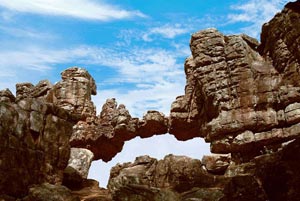Sila Thoranam literally means ‘garland or festoon of rocks’.
Natural Arch, Tirumala hills is a distinctive geological wonder located 1 km (0.6 mi) North of the Tirumala hills temple, near the Chakra Teertham in the state of Andhra Pradesh, India. The Arch is also called Silathoranam in local language (Telugu language: “Sila” means ‘rock’ and “thoranam” means a garland strung over a threshold, connecting two vertical columns or an ‘arch’ as in this case). The arch measures 8 m (26.2 ft) in width and 3 m (9.8 ft) in height, and is naturally formed in the quartzites of Cuddapah Supergroup of Middle to Upper Proterozoic (1600 to 570 Ma) due to natural erosive forces
 The arch is one of the few natural arches or bridges in Asia. But there are many others in other continents, such as the Rainbow Bridge (Arch) and Arches National Park in Utah, USA which depicts 2000 sandstone arches, the Durdle Door arch in Dorset and the Arch of Cut Through in UK, Pravčická brána in Bohemian Switzerland, in Czech Republic, Pont d’Arc in Southern France, Rainbow cave arch in the Galilee Israel, El Arco de Cabo San Lucas in Mexico and London Arch in Australia
The arch is one of the few natural arches or bridges in Asia. But there are many others in other continents, such as the Rainbow Bridge (Arch) and Arches National Park in Utah, USA which depicts 2000 sandstone arches, the Durdle Door arch in Dorset and the Arch of Cut Through in UK, Pravčická brána in Bohemian Switzerland, in Czech Republic, Pont d’Arc in Southern France, Rainbow cave arch in the Galilee Israel, El Arco de Cabo San Lucas in Mexico and London Arch in Australia
Legend
Mythological folklore related to the arch, linked to the famous Tirumala hills temple of Lord Venkateswara, has three versions.
According to one version, the arch resembles the hood of a serpent, a Conch (Sanskrit: Shank and a discus (Sanskrit: chakra) – all symbols of worship in Hindu religion- and considered to be the source of the Idol of Lord Venkateswara or Lord Balaji at the Tirumala hill temple.
The second version is that the main deity in the Tirumala temple is of the same height as the height of the arch.
The third version is that Lord Vishnu (Hindu God) called as Balaji or Venkateswara (the Central deity of Srivaishnava tradition) at the Tirumala temple town, is supposed to have put his first foot down at a place called Padalu or Sreevaripadalu (Telugu language: Divine foot prints) which is the highest point of Tirumala hills, the second step at the location of the arch. Thereafter, the next step is stated to have been placed where his idol is now worshipped in the temple at Tirumala.
History
In the 1980s, during excavations for a geological fault in the Tirumala hills, geologists found this rare geological formation of the rock arch which has two dissimilar sets of rocks with a connecting thin link. The assessed geological age of the rock arch is 1.5 billion years. Formation of the arch is attributed to intensified weathering and erosion of stream action that has withstood the torque of nature.[4] This is a rare geological fault which is technically called in the geological idiom as ‘eparchian unconformity.
Visitor information
The best time to visit the arch is between 6 A.M. and 8 A.M., fog permitting. There is a well maintained garden in front of the arch should visitors wish to rest or wait until fog clears. Sunset is also a good time to visit, as the Arch looks even more striking and mystifying in the light of the setting sun. Seen in the light of a full moon the Arch is said to be “ethereally beautiful

